We’ve all been there – that heart-pounding rush as you realise you’re running late, again. It’s stressful, unprofessional, and can throw your whole day off kilter. But what if you could break free from this cycle of tardiness? Imagine starting each day calm and collected, arriving everywhere with time to spare. It’s not just about being punctual; it’s about reducing stress, improving your relationships, and boosting your overall wellbeing. With a few clever tweaks to your routine, you can transform from a perpetual latecomer to a paragon of punctuality. Ready to make lateness a thing of the past? Here are 15 brilliant hacks to ensure you’re always on time.
Set Your Clocks Fast

Trick your brain by setting all your clocks and watches 5-10 minutes ahead. This simple hack creates a buffer zone, giving you extra time you didn’t know you had. Just remember not to adjust for the difference mentally! For maximum effect, set different clocks to slightly different times, so you can’t rely on a consistent offset.
Prep the Night Before

Lay out your clothes, pack your bag, and prepare your lunch the night before. This eliminates morning decision-making and reduces the risk of forgetting essential items. You’ll start the day feeling organised and ahead of the game. Create a checklist of nightly prep tasks to ensure you don’t miss anything important.
Use a Timer for Routine Tasks

Time yourself doing regular tasks like showering or eating breakfast. Once you know how long these actually take, set a timer to keep yourself on track. You might be surprised at how much time you’ve been wasting! Use this information to create a realistic morning schedule that accounts for your actual habits.
Create a Dedicated “Launch Pad”

Designate a spot near your door for keys, wallet, phone, and anything else you need to grab before leaving. This eliminates the frantic last-minute search for essentials. Make it a habit to always return items to this spot when you come home. Consider adding a small bowl or tray to keep smaller items organised and visible.
Break the Snooze Button Habit

Place your alarm across the room, forcing you to get out of bed to turn it off. This physical movement helps wake you up more effectively. Bonus tip: use a gentle, gradually increasing alarm sound to wake up more naturally. Pair this with a sunlight-simulating alarm clock for an even smoother wake-up experience.
Use Travel Apps for Real-Time Updates

Take advantage of apps that provide real-time traffic and public transport updates. Knowing about delays in advance allows you to adjust your departure time or route. Many of these apps can even send push notifications about your regular commute. Some advanced apps can learn your routines and proactively suggest alternative routes or departure times based on current conditions.
Overestimate Travel Time

Always add an extra 15-20% to your estimated travel time. This buffer accounts for unexpected delays like traffic jams or missed buses. If you arrive early, use the extra time to relax or get a head start on your next task. Keep a log of your actual travel times to refine your estimates over time.
Schedule Buffer Time Between Appointments

Don’t schedule meetings or appointments back-to-back. Allow at least 15 minutes between engagements for travel, preparation, or simply catching your breath. This buffer time reduces stress and helps you stay on schedule all day. Use calendar apps that automatically add buffer time to your appointments.
Use the “Two-Minute Rule”

If a task takes less than two minutes, do it immediately rather than putting it off. This prevents small tasks from piling up and causing delays later. It’s surprisingly effective at keeping your day running smoothly. Apply this rule to both personal and professional tasks for maximum benefit.
Set Multiple Alarms

Use your phone to set a series of alarms – one to start getting ready, one to leave, and one for your estimated arrival time. This creates a countdown effect, keeping you aware of passing time. Personalise the alarm sounds to make them more engaging. Consider using location-based reminders that trigger when you leave or arrive at specific places.
Adopt the “One In, One Out” Rule

For every new commitment you add to your schedule, remove an existing one. This prevents over-scheduling, a common cause of chronic lateness. It also forces you to prioritise your time more effectively. Regularly review your commitments to ensure they align with your current goals and priorities.
Use Visual Cues

Place sticky notes or objects in prominent places to remind you of important events or departure times. Visual cues are harder to ignore than digital reminders. Try colour-coding your reminders for different types of activities. Consider using a large wall calendar or whiteboard for a visual representation of your week or month.
Practice the “Ready to Walk Out” Test

Before sitting down to relax or start a task, ask yourself if you’re ready to walk out the door if needed. If not, take care of any remaining preparations first. This habit ensures you’re always prepared for unexpected schedule changes. Keep a “grab and go” bag packed with essentials for impromptu outings.
Reframe Your Thinking About Arrival Times

Instead of aiming to arrive “on time,” make it your goal to arrive 10-15 minutes early. This mental shift can be powerful in breaking the habit of lateness. Use the early arrival time for productive tasks like reviewing notes or meditation. Celebrate your early arrivals to reinforce this positive habit.
Use Technology to Your Advantage

Explore apps designed to improve punctuality, like those that gamify timekeeping or provide gentle nudges throughout your routine. Many of these apps learn your habits over time and offer personalised suggestions for improvement. Look for apps that sync across devices to keep your schedule consistent whether you’re using your phone, tablet, or computer.
These 23 Titanic Facts That Will Make You See the Tragedy in a New Light

The Titanic, perhaps the most legendary ship ever, was a masterpiece of early 20th-century engineering, funded by American tycoon J.P. Morgan and constructed at the Harland and Wolff Shipyard. Thanks to the movie and other works of popular fiction, any people think they know everything there is to know about the Titanic, but they’re wrong.
Read More: These 23 Titanic Facts That Will Make You See the Tragedy in a New Light
Katy Willis is a writer, master herbalist, master gardener, and certified canine nutritionist who has been writing since 2002. She’s finds joy in learning new and interesting things, and finds history, science, and nature endlessly fascinating.

